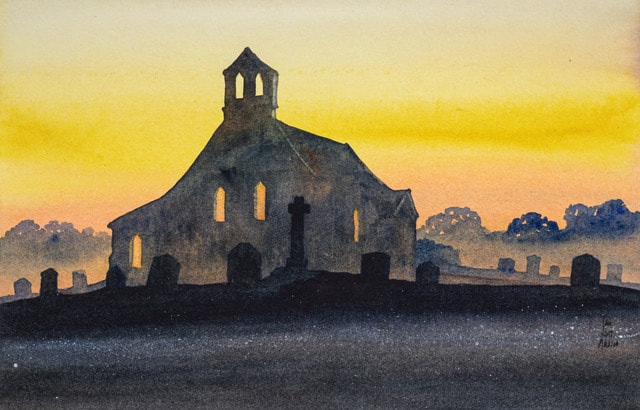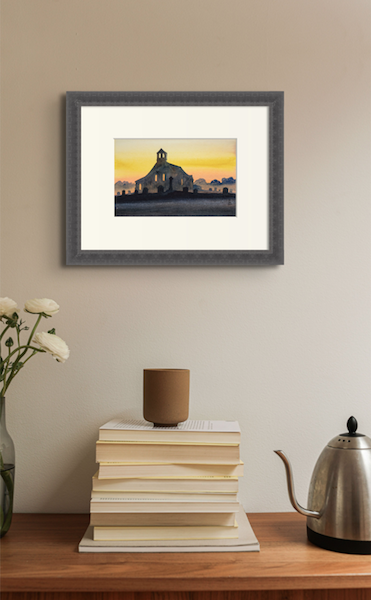St Helena's Church, Austerfield by Ian Scott Massie
Original Watercolour
16" x 12" Mounted size - 10.5" x 7" Image size
Available: unframed @ £340
To shop, please click here
16" x 12" Mounted size - 10.5" x 7" Image size
Available: unframed @ £340
To shop, please click here
THE PILGRIM AND THE DATE OF EASTER
Austerfield is a little village with an old church, close to where the railway crosses into Yorkshire. It’s the birthplace of William Bradford. He was born in 1590. His father died when he was one, so he went to live with his grandfather who died two years later, then to his mother until she died shortly after. His first love was reading the bible, and, after hearing a Puritan minister, he found himself drawn to the teachings of that banned religion.
He joined a group who planned to sail to religiously-tolerant Holland, itself an illegal act. They were betrayed by the ship’s captain and imprisoned, but later escaped to the Netherlands. To fund their cause to worship as they wished, they met with some merchant adventurers who offered to underwrite a voyage to North America in exchange for sourcing and supplying furs.
They sailed on the Speedwell, sister ship to the famous Mayflower. When the Speedwell proved unseaworthy, however, they transferred to the over-laden Mayflower and, eventually, crossed the Atlantic. William became governor of the Plymouth Colony and, during his 30-year tenure, kept a journal, now a key text of American colonial history.
Austerfield has another claim to fame. There was a council held here in 702 and on the agenda was how to calculate the date of Easter. Was the council held here because the place derives its name from Eostre, the goddess of spring, or was Austerfield named since here the date Easter was discussed? We’ll never know the answer but my feeling is that this was a place sacred to Eostre, goddess of spring, renewal and rebirth, and, by holding the council here, the church capitalised on its symbolic power.
And Austerfield feels like a place of power, a feeling reinforced by two pieces of sculpture which pre-date the church. Over the door is an 8th century carving of a dragon - a beast sometimes associated with Eostre. And inside the church, hidden for a long time, is a Sheela Na Gig - a carving of a woman holding open her vulva: an early symbol of feminine power.
He joined a group who planned to sail to religiously-tolerant Holland, itself an illegal act. They were betrayed by the ship’s captain and imprisoned, but later escaped to the Netherlands. To fund their cause to worship as they wished, they met with some merchant adventurers who offered to underwrite a voyage to North America in exchange for sourcing and supplying furs.
They sailed on the Speedwell, sister ship to the famous Mayflower. When the Speedwell proved unseaworthy, however, they transferred to the over-laden Mayflower and, eventually, crossed the Atlantic. William became governor of the Plymouth Colony and, during his 30-year tenure, kept a journal, now a key text of American colonial history.
Austerfield has another claim to fame. There was a council held here in 702 and on the agenda was how to calculate the date of Easter. Was the council held here because the place derives its name from Eostre, the goddess of spring, or was Austerfield named since here the date Easter was discussed? We’ll never know the answer but my feeling is that this was a place sacred to Eostre, goddess of spring, renewal and rebirth, and, by holding the council here, the church capitalised on its symbolic power.
And Austerfield feels like a place of power, a feeling reinforced by two pieces of sculpture which pre-date the church. Over the door is an 8th century carving of a dragon - a beast sometimes associated with Eostre. And inside the church, hidden for a long time, is a Sheela Na Gig - a carving of a woman holding open her vulva: an early symbol of feminine power.





